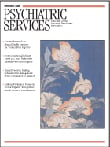Letter
SSRI Prescription Rates After a Terrorist Attack
To the Editor: Although population-based studies and a recent meta-analysis have documented increased prevalence of posttraumatic stress disorder (PTSD) and other mental disorders after terrorist attacks ( 1 , 2 ), other studies have failed to demonstrate concomitant increases in mental health service use ( 3 , 4 ).
Selective serotonin reuptake inhibitors (SSRI) are indicated in the treatment of a number of mental disorders associated with terrorism ( 5 ). We plotted weekly rates of SSRI prescription fills for New York State Medicaid recipients for 2000 and 2001. We determined percentage changes in prescription rates, assessed changes in the slope of the plots before and after September 2001 by determining the statistical significance of the difference in the regression slope coefficients, and analyzed the weekly time series using Box-Jenkins methodology and interrupted times series
For Medicaid recipients living within three miles of the World Trade Center, the rate of prescription fills increased by 18.2 percent in the three months after the attacks compared with the rate in the eight months before the attacks (p=.001), and a statistically significant change in the slope of the plot was noted (p=.01). For recipients who did not live in New York City, the increase was 9.3 percent, which was not statistically significant, nor was the change in the slope of this series significant. In contrast, SSRI prescription rates for both these groups decreased in the three months after September 2000.
For Medicaid recipients living within three miles of the World Trade Center, an ARIMA ( 1 , 1 , 1 ) model provided the best fit for the time series data, and an interrupt term representing a sudden, temporary increase in the prescription rate starting with the first week in November 2001 was statistically significant (p=.001). In a similar model fit to the data for recipients living outside New York City, the interrupt term representing the postattack period was not statistically significant.
Some of the increase in SSRI dispensing may be explained by the wider availability of free services, such as those offered by Project Liberty and Disaster Relief Medicaid. We attempted to address this by basing our time series on rates per person-years of Medicaid eligibility, controlling for an increased number of eligible individuals by including them in the denominator of the rate.
We concluded that an increase in SSRI prescriptions occurred after the attacks and that this effect varied by geographic proximity. Although no causation can be attributed, our results are consistent with knowledge of the increase in mental health pathology after an occurrence of terrorism and have the strength of a plausible gradient effect. We await the release of New York Medicaid data for 2002 to assess whether the increased use of SSRIs among persons living near the World Trade Center was short lived or sustained. However, to the best of our knowledge, ours is the first report of a significant increase in psychoactive drug use associated with physical proximity to these attacks. Our findings contribute to the growing body of knowledge about the pervasive population effects of terrorism and the need to address mental health as part of surge capacity and public health response.
Acknowledgment
The study was funded by grant 1-K01-CE000494 from the Health Protection Research Initiative, Centers for Disease Control and Prevention.
1. Galea S, Ahern J, Resnick H, et al: Psychological sequelae of the September 11 terrorist attacks in New York City. New England Journal of Medicine 346:982-987, 2002Google Scholar
2. DiMaggio C, Galea S: The behavioral consequences of terrorism: a meta-analysis. Academy of Emergency Medicine 13:559-566, 2006Google Scholar
3. Rosenheck R, Fontana A: Use of mental health services by veterans with PTSD after the terrorist attacks of September 11. American Journal of Psychiatry 160:1684-1690, 2003Google Scholar
4. McCarter L, Goldman W: Use of psychotropics in two employee groups directly affected by the events of September 11. Psychiatric Services 53:1366-1368, 2002Google Scholar
5. Lange JT, Lange CL, Cabaltica RB: Primary care treatment of post-traumatic stress disorder. American Family Physician 62:1035-1040,1046, 2000Google Scholar



